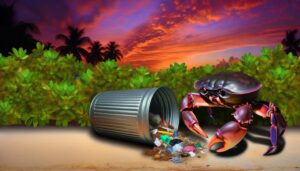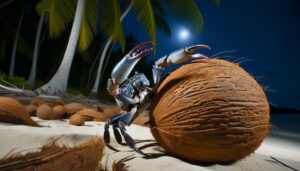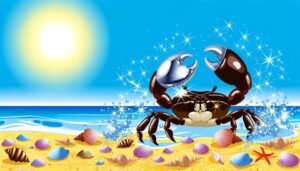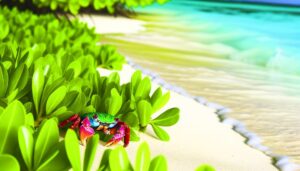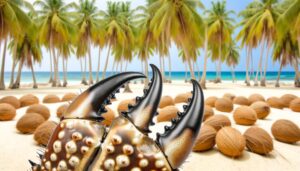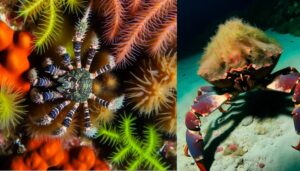Do Coconut Crabs Taste Like Coconut or Not?
Coconut crabs, the largest terrestrial arthropods, don't live in water. They primarily inhabit coastal forests and sandy shorelines in regions within the Indian and Pacific Oceans.
Their highly calcified exoskeletons and dual respiratory systems, featuring both gills and lungs, enable them to thrive in dry environments and minimize water loss. Their unique adaptations, such as robust claws and specialized breathing mechanisms, facilitate their terrestrial lifestyle.
While they can extract oxygen from both air and water, they're more suited to land, only returning to the sea to release their larvae. Discover what secures their evolutionary success on land.
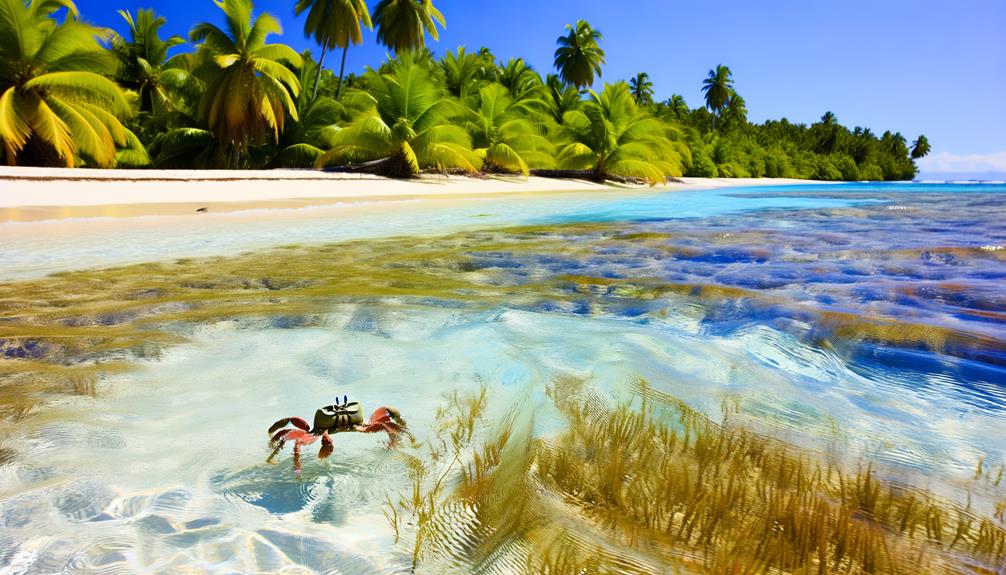
Key Takeaways
- Coconut crabs primarily inhabit coastal forests and sandy shorelines, not living in water.
- They have specialized gills and lungs for breathing air, reducing their need for aquatic environments.
- Their preference for dry environments helps prevent desiccation.
- While they can extract oxygen from water, they thrive on land.
- They molt in moist environments but return to land after the process completes.
What Are Coconut Crabs?
Coconut crabs, known scientifically as Birgus latro, are the largest terrestrial arthropods in the world, capable of growing up to three feet in leg span and weighing up to nine pounds. They belong to the family Coenobitidae and are closely related to hermit crabs.
Unlike their aquatic relatives, coconut crabs are adapted for life on land. Their exoskeletons are highly calcified, providing structural support and protection. They possess powerful pincers capable of exerting a force of up to 740 pounds, enabling them to crack open coconuts, their primary food source.
Despite their terrestrial nature, they exhibit some aquatic traits during their larval stage, requiring a marine environment for initial development. This unique biological profile underscores their adaptability and evolutionary success.
Natural Habitat
The natural habitat of coconut crabs spans coastal forests and sandy shorelines, where they exploit their terrestrial adaptations for survival and reproduction. These environments offer abundant food sources, nesting sites, and shelter. Coconut crabs primarily inhabit regions across the Indian and Pacific Oceans, thriving in areas with limited human interference.
| Region | Key Features | Population Density |
|---|---|---|
| Indian Ocean | Coral reefs, mangroves | High |
| Pacific Ocean | Sandy beaches, coastal forests | Moderate |
| Southeast Asia | Rainforests, limestone caves | Low |
| Remote Islands | Minimal human activity | Very High |
Their preference for terrestrial habitats is driven by the need for dry environments to prevent desiccation. Understanding these preferences helps in conservation efforts and habitat protection, ensuring the species' long-term viability.
Land Adaptations
Frequently exploiting their unique physiological traits, coconut crabs exhibit remarkable land adaptations that enable them to thrive in terrestrial environments. These crabs possess robust exoskeletons that reduce water loss, allowing them to endure extended periods away from aquatic settings.
Additionally, their highly specialized gills, known as branchiostegal lungs, facilitate efficient gas exchange in air. Coconut crabs demonstrate an impressive capacity for osmoregulation, maintaining internal fluid balance despite varying external conditions.
Their powerful claws enable them to climb trees and access food sources, such as coconuts, which are otherwise unreachable. Moreover, their sensory adaptations, including chemoreceptors, allow them to locate food and navigate complex terrestrial landscapes. These combined traits underscore their evolutionary success on land.
Breathing Mechanisms
Coconut crabs exhibit unique respiratory adaptations. They integrate both gills and modified lungs to facilitate gas exchange in varying environments. Studies show that their gills are less developed for aquatic respiration, emphasizing their reliance on lungs for terrestrial survival.
This dual adaptation enables them to thrive in both air and water, enhancing their ecological versatility.
Gill and Lung Function
Unlike other land crabs, coconut crabs have evolved a unique dual respiratory system that incorporates both gills and lungs, enabling them to thrive in diverse environments. This system allows them to extract oxygen from both air and water, providing a significant survival advantage. Gills function effectively in moist environments, while lungs are adapted for air breathing. This dual capability is critical for their foraging and reproductive behaviors, often involving shifts between land and sea.
| Feature | Gills | Lungs |
|---|---|---|
| Environment | Aquatic | Terrestrial |
| Oxygen Source | Dissolved in Water | Atmospheric Air |
| Adaptation Type | Moisture-dependent | Air-dependent |
This respiratory versatility underscores the coconut crab's evolutionary adaptations, enhancing their ecological success.
Air and Water Adaptation
Their ability to efficiently switch between gill and lung use highlights the coconut crab's remarkable adaptation to both terrestrial and aquatic environments, optimizing oxygen intake based on habitat conditions. Coconut crabs possess modified gills and a branchiostegal lung, allowing them to breathe in both air and water.
This adaptation provides several advantages:
- Enhanced Oxygen Absorption: Gills extract dissolved oxygen when submerged, while the lung absorbs atmospheric oxygen on land.
- Survival Flexibility: This dual mechanism enables coconut crabs to thrive in diverse habitats, from coastal waters to inland areas.
- Energy Efficiency: Efficient oxygen uptake reduces metabolic stress and supports their large body size.
Terrestrial Survival Strategy
Utilizing their branchiostegal lung, coconut crabs effectively extract atmospheric oxygen to support their significant metabolic needs while on land. This specialized organ enables them to prosper in terrestrial environments, where their gills, tailored for water, would otherwise be ineffective.
Key Aspects | Details | Implications
— | — | —
Branchiostegal Lung | Extracts oxygen | Sustains high metabolism
Adaptation | Terrestrial | Limits time in water
Efficiency | High | Vital for survival
Their branchiostegal lung operates by maintaining moisture, essential for gas exchange. Unlike aquatic crabs, coconut crabs show reduced dependence on submerged environments. Data indicates they can suffocate if submerged for more than a few hours, underscoring their terrestrial adaptation. Therefore, understanding their unique breathing mechanism reveals why coconut crabs are mainly land-dwellers.
Molting Process
The molting process of coconut crabs involves shedding their exoskeleton to allow for growth and typically occurs in secluded, moist environments to protect their vulnerable new exoskeleton. This process is critical for their development and includes several stages:
- Preparation: The crab accumulates calcium and other nutrients to fortify its new exoskeleton.
- Shedding: The old exoskeleton splits, and the crab extracts itself, a phase that can last several days.
- Hardening: The new exoskeleton solidifies over weeks, during which the crab remains hidden to avoid predation.
Data from studies indicate that molting frequency decreases with age: juveniles molt every few months, while adults may molt annually. This process is energy-intensive, demanding significant metabolic resources.
Diet and Feeding
Coconut crabs exhibit diverse scavenging and foraging behaviors, often targeting carrion, fruits, and nuts. Their diet mainly consists of high-energy food sources, such as coconuts and other fleshy fruits, which provide essential nutrients.
Observational studies indicate they can exert considerable force to access these food items, reflecting their specialized feeding adaptations.
Scavenging and Foraging Habits
Through a combination of keen sensory perception and opportunistic behavior, coconut crabs exhibit remarkable adaptability in their scavenging and foraging habits. Their ability to detect food sources involves a sophisticated olfactory system, allowing them to locate sustenance from considerable distances.
Analytical observations indicate that their foraging strategy includes:
- Nocturnal Activity: Coconut crabs primarily forage at night, reducing predation risks and increasing access to food sources.
- Terrain Navigation: They utilize their powerful claws and robust limbs to traverse diverse terrains, from sandy beaches to rocky outcrops.
- Object Manipulation: Their dexterous claws enable them to handle and process various food items effectively, enhancing their scavenging efficiency.
These adaptive behaviors underscore their success in diverse habitats, contributing to their ecological niche as effective scavengers.
Preferred Food Sources
A diverse diet comprising fruits, nuts, carrion, and smaller animals characterizes the feeding habits of coconut crabs. They exhibit a preference for coconuts, using their powerful claws to break open the hard shells.
Studies indicate that approximately 50% of their diet consists of plant matter, while the remaining 50% includes animal sources. They also consume dead animals, playing an important ecological role as scavengers. They've been observed hunting smaller animals, showcasing their opportunistic feeding behavior.
In controlled environments, coconut crabs have demonstrated a strong attraction to protein-rich foods. This varied diet ensures they obtain essential nutrients, supporting their growth and reproduction. Understanding their dietary preferences helps in conserving their natural habitats and managing their populations effectively.
Reproduction Cycle
Researchers have documented that female coconut crabs carry fertilized eggs under their abdomen for approximately one month before releasing them into the sea.
The reproductive cycle of coconut crabs is marked by several key stages:
- Mating: This occurs on land, where males deposit spermatophores on the females.
- Egg development: After fertilization, females brood the eggs under their abdomen for around 30 days.
- Larval release: Females migrate to the shoreline, releasing the larvae into the ocean, where they undergo several planktonic stages before settling on land.
This process ensures that the larvae have a greater chance of survival through their critical early stages.
Predators and Threats
Coconut crabs face predation from various sources, including large birds, pigs, and humans, impacting their population dynamics to a noteworthy extent. Studies indicate that juvenile crabs are particularly vulnerable, with predation accounting for about 50% of juvenile mortality.
Human activity, such as hunting and habitat destruction, intensifies their threat levels. Data reveals a 30% decline in coconut crab populations in areas with high human presence. Additionally, invasive species, such as rats, have been documented preying on juvenile crabs, further destabilizing their populations.
The combination of these factors requires targeted conservation efforts. Effective strategies include habitat protection, regulated hunting, and invasive species control to guarantee the sustainability of coconut crab populations.
Lifespan and Growth
Lifespan and growth rates of coconut crabs reveal significant insights into their developmental stages and overall population resilience. Coconut crabs can live up to 60 years, depending on environmental conditions and availability of resources. Their growth follows a complex molting process, which slows down noticeably as they age.
Three key points about their growth and lifespan are:
- Juvenile Stage: Coconut crabs spend their initial years in a larval stage, living in the ocean for 3-4 weeks before moving to land.
- Molting Frequency: Young crabs molt frequently, about once a year, while older crabs molt every few years.
- Size and Age Correlation: Larger crabs are typically older, with some reaching over 9 pounds and a leg span of up to 3 feet.
Understanding these factors is pivotal for studying their population dynamics.
Conservation Efforts
Effective conservation efforts are essential to secure the survival of coconut crabs, given their vulnerability to habitat loss and overharvesting. Current data shows a marked decline in coconut crab populations in several regions.
Key strategies include establishing marine protected areas and enforcing strict harvesting regulations. Studies indicate that protected zones can boost population numbers by 30% over a decade. Additionally, community-based conservation programs have proven effective, educating locals on sustainable practices.
Genetic research is also underway to understand population dynamics better and develop targeted conservation measures. By combining habitat protection, regulatory enforcement, community engagement, and scientific research, stakeholders aim to halt and reverse the decline of this unique species.
Conclusion
Coconut crabs, while adept climbers and formidable land dwellers, aren't aquatic creatures. They've evolved unique adaptations like specialized breathing mechanisms and molting processes to thrive on land.
These fascinating crustaceans, akin to armored knights of the forest, face numerous threats from predators and habitat loss. With lifespans reaching several decades, their survival hinges on robust conservation efforts.
Data underscores the urgent need for protective measures to guarantee these terrestrial giants don't vanish.

